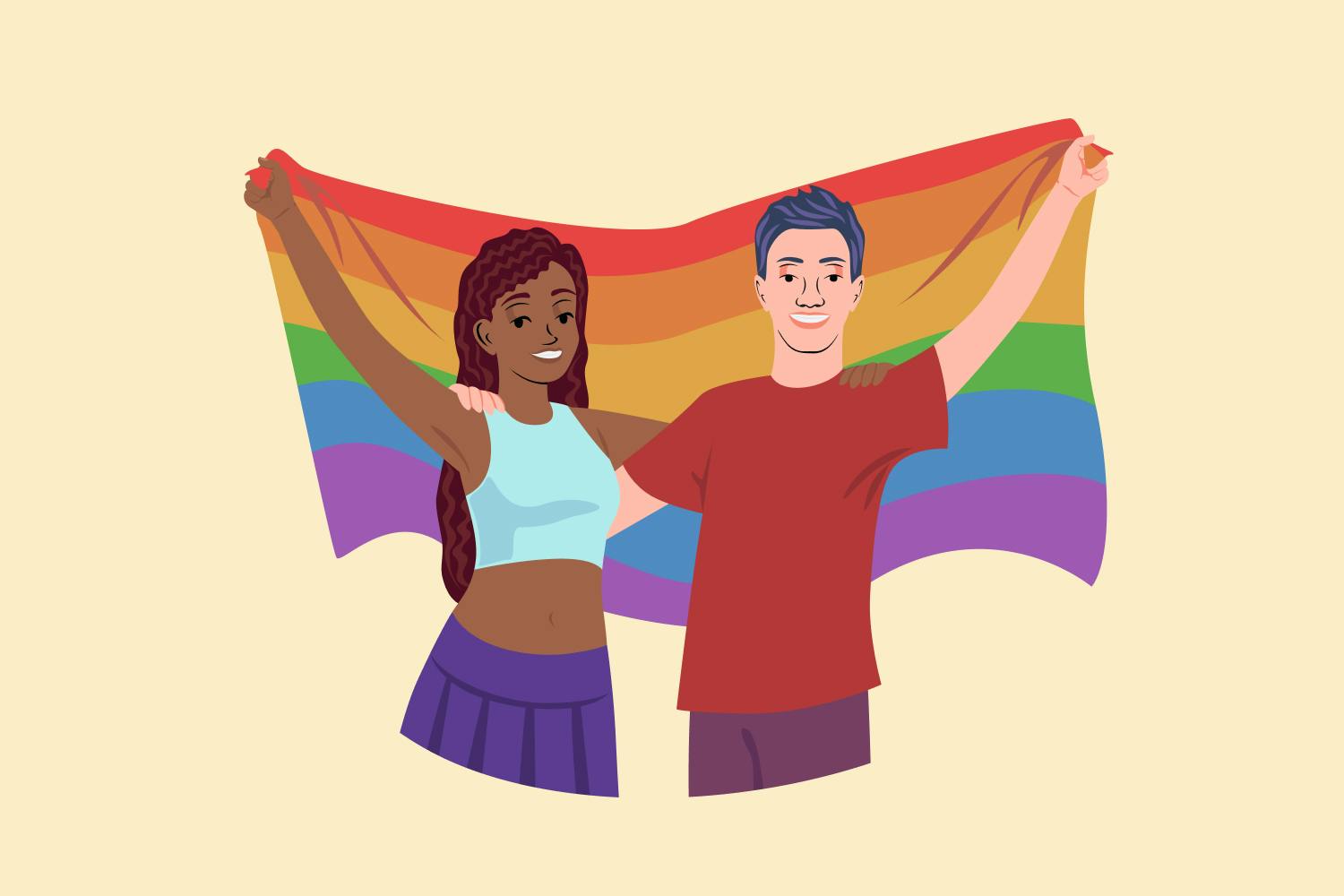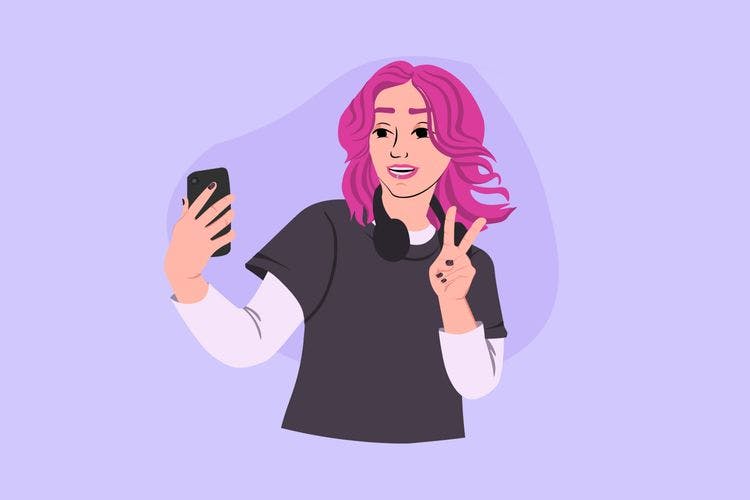Live, Love, Pride: LGBTQ+ Vocabulary Guide in Celebration of Pride Month


You will get a promo code with a discount for our app courses after reading this article.
Contents
Today, June is known as Pride Month – a time dedicated to celebrating solidarity and honor for the LGBTQIA+ community. And since we are about to enter this joyful and powerful month, we’ve decided to help you understand the modern sexuality dictionary and everything you need to embrace inclusivity and learn the language of love and acceptance. So buckle up; we are about to start!
Pride Month History: Why Does It Matter
Nowadays, Pride Month is a global concept, but its current reach and significance weren’t always the case. It all started 54 years ago, in June 1969. The iconic Stonewall Inn, a modest gay bar in New York City (by the way, it is still open), lies at the heart of Pride Month. The LGBTQ+ community has experienced years of systemic oppression, police harassment, and social discrimination. But everything changed one steamy summer night in the Stonewall.
Sadly, police raids on gay bars were common in the 1960s. But this time, the typical attack turned into demonstrations and even riots. After the Stonewall Uprising, LGBTQ+ activists and allies began organizing protests and marches to demand equal rights and end discrimination. These early demonstrations empowered the community and ignited a spark of resilience and determination. What looked like a single-day riot turned into a month of courageous fighting for rights.
Understanding the importance of the Pride Month concept today is essential. It reminds us of the bravery of LGBTQ+ activists and honors the sacrifices made. Also, it highlights the progress achieved in legal protections, anti-discrimination policies, and social acceptance.
The least we can do is learn and use the proper LGBT terminology glossary to create a sense of allyship and encourage support for the queer community. They are still fighting for their rights as, unfortunately, there is still a lot of homophobia and discrimination. So let’s foster empathy and understanding among all of us during Pride Month and every day of our lives.
LGBTQ Labels and Definitions
So, what does LGBTQIA+ stand for? Initially, it was the short acronym “LGBT,” which meant “lesbians, gays, bisexuals, and transgenders.” But today, it has expanded since there are plenty of new terms. Q stands for queers (an umbrella term for all non-heterosexual and non-cisgender people), I – for intersex (term to describe individuals who are born with variations of sex characteristics that do not fit with binary definitions of male or female bodies), A – for allies (community supporters), and + includes all other gender identities and expressions, orientations, and more. Here is some general LGBTQ terminology to get started:
- Gender identity – one’s internal sense of gender that aligns or doesn’t with the sex assigned to them at birth.
- Gender diverse – an umbrella term for people identifying with various gender identities, including non-binary, genderqueer, and genderfluid.
- Gender expression – how one presents their gender to others through behavior, clothing, hairstyles, and other outward features.
- Sexual orientation – one’s long-term attraction to others on an emotional, romantic, or sexual level. It can be to people of the same, different, both, or multiple genders.
These terms are essential to understand some basic information about the queer community. Yet, there are a lot more things to learn about LGBTQ labels and their meanings.
- Lesbian – a woman emotionally, romantically, or sexually attracted to other women.
- Gay – a man emotionally, romantically, or sexually attracted to other men; also an umbrella term for anyone within the LGBTQ+ community.
- Bisexual – a person emotionally, physically, or both attracted to men and women.
- Transgender – general term for individuals whose gender identity differs from the sex assigned to them at birth.
- Non-binary – a gender identity that doesn’t exclusively align with either male or female.
- Pansexual – a person emotionally and physically attracted to other people regardless of their gender. This term can be interlinked with bisexuality, but it is still slightly different since it primarily describes emotional attachment.
- Ally – a person who supports and advocates the rights of the LGBTQIA+ community, even if they do not personally identify as queer.
- Androgynous – a person whose gender expression and appearance blend masculine and feminine qualities, often appearing gender-neutral.
- Skoliosexual – an individual attracted to people with diverse gender identities or expressions, including non-binary, genderqueer, or gender non-conforming.
- Demisexual – a person who experiences sexual attraction only after forming a strong emotional bond or connection with someone.
- Genderfluid – an adjective describing individuals whose gender identity and expression fluctuate between different genders over time.
- Gender non-conforming – a person whose gender expression doesn’t align with societal expectations or norms associated with their assigned sex at birth.
- Questioning – an individual exploring or unsure about their sexual orientation or gender identity.
These LGBT vocabulary words and labels represent a diverse and evolving spectrum of identities and orientations within the community. Keep in mind that it is not a comprehensive list since there are many more words in this living and evolving glossary. Yet, it is essential to learn such terms to remain respectful and supportive when communicating with LGBTQIA+ representatives.
LGBTQ Dictionary: Understanding Pronouns and Gender-Inclusive Language
Appropriate language is a powerful tool to show respect to our interlocutors and create an affirming and supportive environment. You don’t only have to understand basic grammar rules but also all the inclusivity nuances, especially when it comes to conversations with LGBTQIA+ community members.
Pronouns
In English, pronouns are words used to replace nouns and noun phrases to refer to a person or an object. There are many types of this part of speech, and gender pronouns are one of them. You are probably familiar with the common she/her and he/him, but remember that queer people may use different words to affirm their gender identity. Here are some pronouns you can hear from LGBTQIA+ representatives:
- they/them – used mainly by non-binary, genderqueer, or gender non-conforming individuals;
- ze/hir – these pronouns are common for people who don’t identify within the traditional gender binary;
- xe/xem – an alternative option for those who prefer non-binary or gender-neutral pronoun set;
- she/they and he/they – this combination is another alternative for non-binary people or questioning, e.g., a person with she/they pronouns can identify as a woman but as non-binary;
- name – some people feel uncomfortable using the pronouns; they prefer you to call them by name.
Although understanding and memorizing these pronouns might be challenging for some people (and mind you, this is not even a complete list), you need to realize how vital their usage is. It is a considerable step toward creating a more supportive and accepting society for individuals within the LGBTQIA+ community.
Gender-Inclusive Language
Another important thing about inclusivity and tolerance is using gender-neutral language. Such broad terms avoid assumptions about a person’s gender and ensure that individuals of all identities feel acknowledged and respected. Here are the main aspects of gender-neutral language to consider:
- Instead of using gender-specific titles like Mr., Mrs., Miss, or Ms., opt for gender-inclusive alternatives such as Mx.
- Choose gender-neutral terms whenever possible when referring to someone in business or professional settings. For example, use inclusive words “firefighter” or “police officer” instead of “fireman” and “policeman.”
- Use general neutral terms like “person” or “individual” instead of “guy,” “girl,” “man,” or “woman.”
- Avoid making assumptions about one’s marital status and using gender-specific terms “husband” and “wife.” Instead, replace them with neutral words “partner” or “spouse.”
Implementing gender-inclusive language in your daily routine is simple but also very significant. It can make people of all gender identities and orientations feel seen, valued, and accepted. And we believe that this is a huge step toward creating an acknowledged society that affirms the diverse experiences within the LGBTQIA+ community and beyond.
3
Bonus! Popular LGBTQ Terms and Slang Expressions
In addition to common terms related to genders, orientations, and identities, the LGBTQIA+ community is famous for unique slang expressions and iconic sayings. Some are popular among the representatives, while others have already become routine for most native speakers. So now that you’ve learned the basics, like queer LGBTQ meaning, let’s expand your vocabulary a bit more with this list of modern slang expressions and terms.
- Tea – gossip; to spill the tea means to share the latest juicy news.
- Friend of Dorothy – an old-school term referring to representatives of the LGBT community (mostly gay men). This expression is based on Judy Garland’s role as Dorothy in The Wizard of Oz. The actress is considered a gay icon.
- 100-footer – a person whose LGBTQ identity is easily recognizable (like from a 100-foot distance).
- Coming out – disclosing one’s sexual orientation or gender identity to others.
- Bear – in the gay community, larger hairy men with a more rugged appearance and demeanor.
- Cishet – a shortened term for “cisgender heterosexual.”
- Daddy – this word refers to an older, usually more dominant or financially stable partner.
- Enby – short for “non-binary” that shares the same meaning.
- Gaydar – one’s ability to intuitively or accurately recognize whether another person is gay based on visual cues, behavior, or other subtle indicators.
- To throw shade – to criticize or make negative and mocking remarks about someone publicly.
- Serving – used to describe someone presenting themselves with style, confidence, and attitude. Typically refers to one’s overall appearance, fashion choices, or actions.
Yas, queens! Now you know much more slang expressions to feel confident during conversations with LGBTQIA+ representatives. Yet, it is essential to remember that these terms, and language in general, are constantly evolving. It means that the definitions and usage of words may differ depending on the context or individual preferences. Hence, you need to stay polite and respectful and carefully use any term to avoid misunderstandings and offending others.
Embracing Diversity and Expanding Vocabulary with Promova
All people are different and have various preferences in everything – from favorite food to online education. And in Promova, we celebrate the uniqueness of each student and do our best to create an inclusive and helpful environment for people with different backgrounds. Here’s how Promova can support your language learning experience:
- Personal and group lessons with professional tutors. Promova’s lessons go beyond the basics. Whether you prefer studying one-on-one or in a group, you can expect a personalized approach, tons of helpful materials, and friendly and inviting company.
- Free trials. If you want to try some Promova features beforehand, you can always access our free trial lessons. It is a great way to get acquainted with the studying process before making final decisions.
- Conversation Club and speaking classes. These options are great for those who aim to practice their conversational skills and master pronunciation. Speaking classes are great if you seek some professional advice. Free Conversation Club, on the other hand, is perfect for meeting new people and discussing interesting topics while practicing communication skills.
Moreover, you can get a convenient Promova application for your iOS or Android device. It is great for those who prefer studying on the go – you have access to dozens of learning materials and practice exercises; you can also track your progress within the application. And these are only a few possibilities available for Promova students – you are the one to choose the best for yourself.
Conclusion
To sum up, everyone can contribute to a more inclusive and accepting society. All it takes is to treat other people with kindness and respect, use appropriate language, and understand proper terminology. We hope that now you know a bit more about different gender identities, orientations, and inclusive language. And keep in mind: “There is no such thing as being extra in June.” Happy Pride Month!
Use your discount and learn languages with Promova
Start learningFAQ
What is the term gender-expansive meaning?
This word refers to a broad understanding of gender beyond the traditional binary concepts of male and female. It acknowledges all identities and expressions; gender-expansive people may identify as non-binary, genderqueer, genderfluid, etc.
How do I know the pronouns of someone I’ve just met?
You can start by introducing yourself with your own pronouns. This way, you will create a safe environment and make your interlocutor feel comfortable sharing theirs. Also, you can initially use gender-neutral terms and pronouns, avoiding any gender-specific ones. Finally, you can simply ask the person you are talking to and, of course, respect their response.
Is understanding gender-inclusive terms essential for language learners?
While it is not a traditional part of the English studying program, it is still a significant topic. If you want to effectively and freely communicate with native speakers, you need to understand the basic concepts of gender-inclusive language and use neutral terms. It helps stay respectful when talking to people with different backgrounds and prevents misunderstandings or offenses.
Are there any regional or cultural variations of LGBTQA+ vocabulary to be aware of?
Yes, LGBTQA+ vocabulary can vary in different regional or cultural contexts. For example, some Indigenous cultures use the term “two-spirit” to describe a person with both masculine and feminine features or a spiritual connection to both genders (something similar to being non-binary or bisexual).



Comments